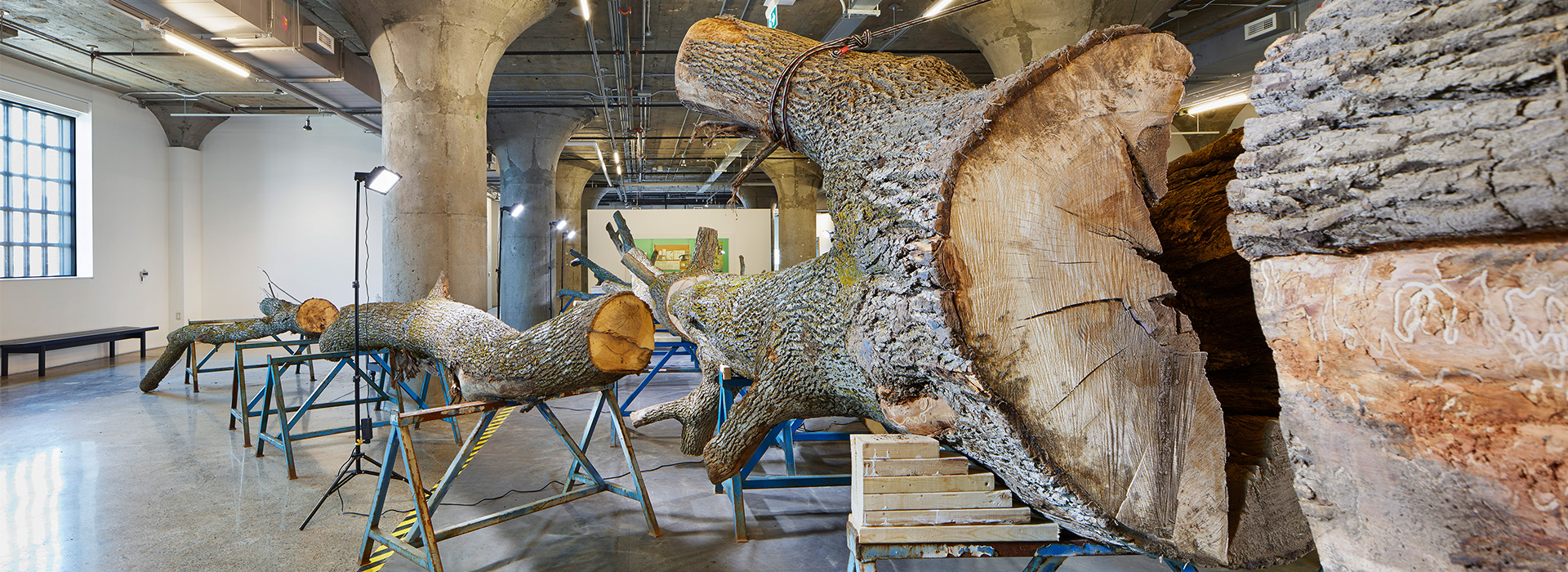The Life of a Dead Tree
Mark Dion
May 24–July 28, 2019
Floor 3
Artist Mark Dion brings a massive, fully grown, deceased tree, along with its inhabitants, to MOCA for the museum’s first summer exhibition in the Tower Automotive Building. This specially conceived project marks the 100th anniversary of the Tower Automotive building and brings attention to our role in observing and caring for Ontario’s natural ecosystems.
With the support of the Faculty of Forestry at the University of Toronto and other partners, visitors can observe and participate in a kind-of autopsy of the tree that will unfold over the course of a two-month exhibition period. This shared investigation will remove, preserve and document all the various life forms the tree continues to support. Most importantly, the project will act as a site for conversations around specific pernicious, invasive insects threatening North American forests, such as the Emerald Ash Borer and Elm Bark Beetle.
Everything from beetles to liverworts, fungi to bug galleries will be revealed during the examination. We will likely find both indigenous samples and invasive species — those that play an active, positive role in the natural cycle of life and death, as well as with those that threaten the vital green infrastructure of our cities, forests and the continent. These discoveries will be documented and added to a growing collection of data, equipment and imagery displayed around the tree.
Trees and forests have long populated Dion’s imagination and a particular body of production. He is well-known for artworks that question how we experience, study, display and think about the natural world. Through this particular project, a range of partners will be called upon to help expand the conversation and research being undertaken at MOCA. Dion states: “to build a culture of nature that features regeneration over destruction, sustainability over depletion and nurturing over domination, it requires input from a diverse collation of thinkers, makers, and doers. Art is one of many areas which can be important to this constellation.”
Mark Dion has received numerous awards, including the ninth annual Larry Aldrich Foundation Award (2001) The Joan Mitchell Foundation Award (2007) and the Smithsonian American Art Museum’s Lucida Art Award (2008). His work was included in dOCUMENTA 13 and he has had major exhibitions at museums including, the Miami Art Museum; the Museum of Modern Art, New York; and in London at Tate Modern and the Natural History Museum. In 2006, Neukom Vivarium, a permanent outdoor installation and learning lab for the Olympic Sculpture Park, was commissioned by the Seattle Art Museum. Opening on May 4, 2019, Storm King Art Center will present Mark Dion: Follies, the first exhibition to unite Mark Dion’s signature folly works into a major survey.
This project has been made possible through the support and knowledge of multiple individuals and organizations. We would like to specifically thank Dr. Sandy Smith, Professor, Forest Health, Melanie Sifton, PhD Student, Urban Forest Health, and Alexandra Ntoukas, Master of Landscape Architecture candidate at the Faculty of Forestry, University of Toronto; Doug Currie, Vice-President, Department of Natural History and Senior Curator of Entomology and Mateus Pepinelli, Postdoctoral Fellow, Royal Ontario Museum; Jonathan Arnold, Shady Lane Expert Tree Care; Matthew Wells – illustrations, Cengiz Tanc – camera; Catherine Tammaro, Seated Wyandot Faithkeeper; Camille Georgeson-Usher, Director of Programming, Aboriginal Curatorial Collective; Adi Puterman, Associate Director, Tanya Bonakdar Gallery, New York.
Update
We’re excited to have relocated the large ash tree to Evergreen Brick Works. The tree’s story will be extended in this new outdoor home, where it will host a myriad of living organisms as it slowly decomposes. Various partners will be invited to continue their research and the conversations that this project fostered.
Marc Dion & Mark Mayer in Conversation
Join us
In-museum Scientist: Alexandra Ntoukas
Every Thursday–Sunday
May 24–July 28
Throughout the duration of The Life of a Dead Tree, MOCA’s in-museum scientist, Alexandra Ntoukas, will conduct research and interact with the ash tree on display. She will be collecting data on the types of insects found within the tree; the physical impressions that destructive insects leave on the surfaces of trees; and the ways in which molds and fungi decompose trees. Visitors will be able to experience and learn from Alexandra’s research as the exhibition unfolds. Every Thursday–Sunday, Ntoukas will be available for demonstrations and discussions around her work.



